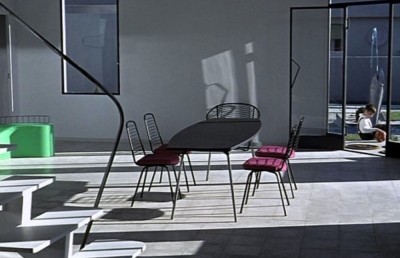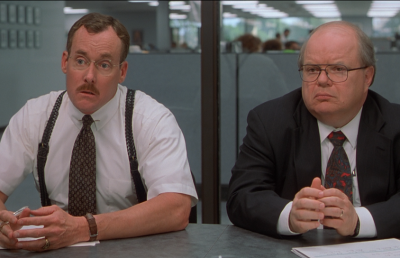Bad Lieutenant: Beyond Expectations
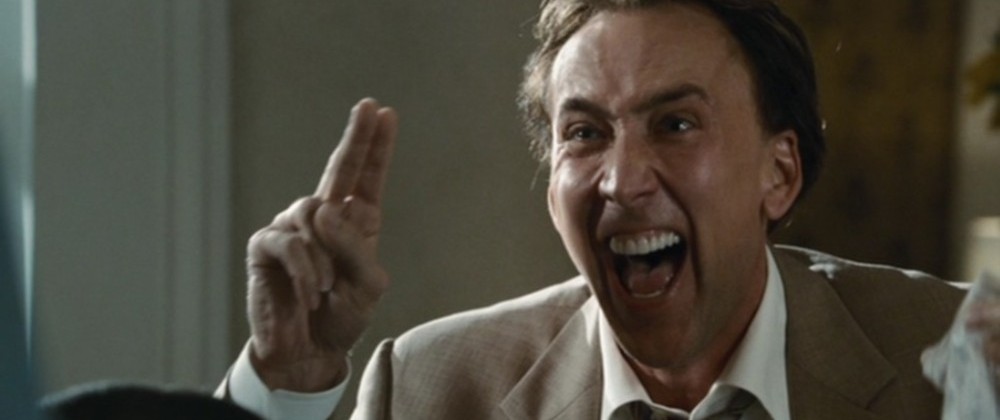
For the average audience member viewing Werner Herzog’s Bad Lieutenant: Port of Call New Orleans without prior knowledge of the director’s work or sensibilities, the film’s content was often a shock. Upon its North-American release, nothing about the film’s marketing campaign indicated that it was anything other than a grim, dyed in the wool cop thriller exploring the concept of a corrupt police officer’s place in the institutional failure to protect the American city. The film’s poster featured bleak, desaturated close-ups of the lead actors’ faces set against a black background with the secondary characters posing dramatically amid a misty crime scene below. The little-seen trailer offered more clues to the film’s true nature, showing the audience glimpses of Nicholas Cage’s deranged behavior as Terrence McDonagh but kept expectations in line for the most part. Upon the film’s release however, audiences got far more than they bargained for and even fans of Herzog were taken aback at the sheer audacity and absurdity of the film.
Released by a major studio, Bad Lieutenant: Port of Call New Orleans (referred to henceforth as Bad Lieutenant) initially plays into Hollywood’s structural game, fitting neatly into the crooked cop genre. For lack of a better option, it was marketed as such and failed to make much of an impact at the box office, killing the producers’ dream of a new franchise. Viewers who took the plunge and bought a ticket however were treated to Herzog’s bizarre take on a tired subject: an absurd, gonzo version of a vigilante movie that was both considerably darker than expected but also side-splittingly funny. It’s this humor that most surprised, shocked, offended and thrilled audiences: psychotic, drug-abusing police officers are not supposed to be humorous. At most, they can be anti-heroes such as Denzel Washington’s “Alonzo” in Training Day but there must be consequences to the crooked cop’s actions: the police represent order and order must be maintained. ??Bad Lieutenant??’s McDonagh not only escapes the consequences of his actions, he revels in them and miraculously uses them to improve and better his life. In an era where Hollywood has become increasingly cautious, market-testing films within an inch of their lives in order to perfectly target certain demographics, ??Bad Lieutenant??’s rapid and shocking alternations from dark drama to gonzo comedy were unexpected, unorthodox, artistically rewarding but most importantly shocking, leading audiences to question the work they’d just seen on screen. In this piece, I will take a look at some of the film’s strategies to upend audience expectations along with an analysis of the film’s underreported comedic elements and how Herzog and Cage integrate them into the whole without completely divorcing themselves from the film’s original dramatic, nihilistic premise.
Introducing the Bad Lieutenant
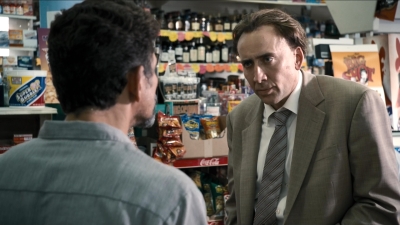
Opening with a view of a water-snake swimming through the dark, filthy water of a flooded New Orleans jail after Hurricane Katrina; ??Bad Lieutenant??’s first shots are a sign of things to come: this film will attempt to play it straight but will never let you forget that its creator is German maverick filmmaker Werner Herzog, whose filmic explorations of animal behavior and the natural world are well documented. The film’s titular Lieutenant will attempt the same trick, trying desperately to be seen as a “proper” member of society all the while embodying the crime and depravity slowly ripping New Orleans apart. After some rapid exposition in which Terrence McDonagh (Nicholas Cage)’s unscrupulous behavior and contrasting good-heart are revealed as he saves a drowning prisoner, we cut to the film’s first major plot point: McDonagh’s badly injured back will henceforth keep him on powerful narcotics for the rest of his life, fueling his addictive and irrational behavior. From this, audience members can logically conclude that the film’s titular “??Bad Lieutenant??” will go down a path of extortion and corruption but none expect Cage to become the grotesque caricature of a man that he slowly but surely comes to inhabit throughout the film. Initially the film follows the beaten path: McDonagh’s drug use is tragic, not funny. The same can be said for the mass-homicides he investigates and his initial transgressions of authority (he makes sure a frightened witness’ marijuana charge is “lost” in the system in exchange for collaboration). Yet even early on in the film there are hints that McDonagh is a grotesque character. His pronounced limp and slumping shoulders lend him an ogre’s frame, a performance element that Cage constantly and consistently emphasizes through the film with increasing intensity.
McDonagh’s abominable posture is compounded by his increasingly glassy-eyed demeanor and slurred speech as he descends into the madness of drug abuse induced paranoia and hallucination. The characters he interacts with are cut from the same exaggerated cloth: antagonist Big Fate, played by rapper and MTV television personality Xzibit (who was certainly not cast for the subtlety of his performance) has a rap sheet that includes rape and sodomy, charges more fit for a psychopath than a leader of organized crime. McDonagh’s love interest meanwhile is Hollywood’s archetypical “hooker with a heart of gold” whose sweetness contrasts bitterly with her line of work. If the film’s remaining cast have less detailed personalities, it’s only to highlight their roles as walking stereotypes: the bleary eyed, overworked police chief, the stressed-out bookie uttering vague threats of mob retribution, the sarcastic Italian gangster who may have watched a few too many genre movies himself, etc. What’s surprising however is that initially, each of these characters is taken seriously as they all fit perfectly within the context of a “straight” cop film: it’s only as the situations become increasingly far-fetched that each character reveals him or herself to be so exaggerated. The film’s defining moment in this regard is McDonagh’s initial robbery and sexual assault of the two intoxicated patrons leaving a nightclub. That McDonagh would take their drugs or even coerce the girl into sex is not entirely unexpected but Herzog’s graphic depiction of the act and Cage’s creepily detailed narration mark the first time that the audience must make an uncomfortable choice: do they laugh? Avert their gaze? Condemn the lieutenant? There’s no easy answer and if there’s a right one, the film never spells it out.
The Comedy and discomfort of expectations
To laugh or not isn’t a conscious decision. An emotional reaction provoked by a variety of factors, laughter is one of humanity’s most expressive gestures. For all but the most serious, grim and judgmental of viewers, Bad Lieutenant will provoke laughter as the previously described grotesque characters encounter increasingly ludicrous situations. The audience does however have a choice in HOW they laugh. When McDonagh assaults the club patron, the most encountered reaction is that of shock and nervous laughter to conceal our discomfort that the anti-hero we identified with could be capable of such a morally bankrupt act. The scene is so over-the-top that we can’t help but giggle yet everything prior to this had us expecting a dramatic police-thriller. It’s the incongruence of our expectations when faced with the film’s true nature that provides much of ??Bad Lieutenant??’s humor. At first, we laugh to keep from crying, later we laugh out of sheer shock and disbelief and finally we laugh because what’s presented to us is actually quite funny; this progression takes place almost unnoticed as the film escalates in absurdity rather than in tension. Initially however, we are shocked: McDonagh smokes crack, has public sex, shoots his gun into the air to force his victim’s boyfriend to watch and even provides lurid color commentary on his own actions. In the case of his first sexual extortion in front of the nightclub, the boyfriend’s words mirror our own thoughts: “you’ve got to be fucking kidding me”.
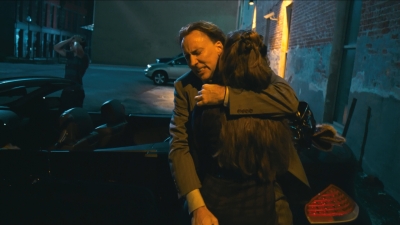
McDonagh follows this up by accidentally snorting heroin and robbing his prostitute girlfriend’s client of his cocaine but immediately following this, he’s back on the job doing serious investigative work. He bravely volunteers to sneak inside a suspect’s house to arrest him and does so without the slightest incident. We’re again faced with a serious policeman suffering under the weight of constant pain and an addictive personality, not an unhinged psychopath abusing his powers. How can we as an audience reconcile these two behaviors? This two-faced nature isn’t uncommon amongst drug addicts but it is usually presented on screen as a tragic flaw. Here, Herzog dares us to laugh at Cage’s theatrics presenting drug abuse in way few other directors have. Notably, only Johnny Depp’s portrayal of Hunter S. Thompson in Terry Gilliam’s Fear and Loathing in Las Vegas comes close to the hilarious if disturbing portrayal of drug use in Herzog and Cage’s Bad Lieutenant. Of course, Cage’s drug use is also mined for lighter laughs: when he finds out a female officer who’s romantically interested in him works in the property room (a drug cache of nigh-mythical stature at that point in the film), Cage does a double take worthy of a Tex Avery cartoon, taking the film’s physical comedy to a new level. Later, when Cage finally gets access to said property room in what his superiors think is a demotion, his appearance is that of a kid in a candy store as he excitedly takes possession of impounded narcotics with a total lack of subtlety. The film’s constant tug of war between the tragedy and comedy of McDonagh’s drug abuse is one of the many elements that makes viewing the film a uniquely disorienting experience, but its impact is even stronger when combined with the maelstrom that is McDonagh’s personal and professional life and the film’s increasingly convoluted storyline.
In addition to McDonagh’s own substance abuse and that of his prostitute girlfriend, his father and mother in law are both alcoholics, his father’s attempt at sobriety creating tension within their marriage. Taken together, the McDonaghs are the epitome of tragic addiction, a case to contemplate, not to ridicule and victims of social-issues to which there are no easy answers. Yet Herzog mines them for laughs as well, allowing us an up close and personal look at their quarrels that still shocks years after the dominance of trash-TV. Switching from drug-addled psycho to dotting son instantly in their presence, Terrence once again tries to present himself as respectable in the face of severe mental and physical issues. Incidentally, his family’s return to grace will later provide one of the film’s most surprising comedic twists. The good son offers to take his father’s golden retriever for the weekend, dumping it on his girlfriend before realizing that he has no idea what the dog’s name is. Later, he rides around town with both the smiling pooch and a young witness in tow, an increasingly bizarre site worthy of a bad television sitcom. One can almost imagine the lowbrow potential of a series where this grizzled officer solves crimes with a shy teenaged sidekick and the world’s least menacing dog. Throw in his equally unbalanced girlfriend – now with a black eye delivered by an abusive john – and you’ve got the fixings for a light hearted police-comedy…except the film then violently thrusts us into its single most uncomfortable scene, one whose dramatic premise is so dark that most people laugh as a defense mechanism in the face of its brutality.
If Cage’s initial drug robbery and fornication is the film’s first uncomfortably graphic and simultaneously funny moment, the asphyxiation of Mrs. Fahringer and the extortion of her nurse is the film’s zenith in this regard. The high point of Cage’s manic, drug-fueled, play-by-his-own-rules bad cop character, the scene destroys the cliché of the dedicated lawman handicapped by the system and instead reveals the frightening reality of the vicious, power-mad policeman who’ll stop at nothing to get the “bad guy”. Caught between the absurdity of the character doing these horrendous actions, the seriousness and repulsiveness of his abuse and the film’s previous switches between dark-comedy and grim drama, the viewer has absolutely no cue on how to react. Some laugh to keep from crying, others guffaw loudly others avert their gaze and others just sit slack-jawed but none leave unmoved, making the scene a prime example of how The Bad Lieutenant plays with audience expectations.
The scene begins with the Lieutenant hiding behind a doorframe holding an electric razor, shaving. Already, there’s a dissonance between the expected tone of the scene and what we’re seeing: yes, it makes sense for McDonagh to hide behind the door in order to avoid detection…but why is he shaving? Couldn’t he have waited? Didn’t he realize this detracted from his ability to be taken serious by those whom he intends to interrogate? Or was he simply too rundown and haggard to care? The latter seems most likely. McDonagh proceeds to demand information from Mrs. Fahringer’s nurse whose grandson is the (now runaway) witness in the case against Big Fate, appealing to Fahringer’s nurse in grandiose terms (this was a massacre…children were executed). While McDonagh must view his speech as a passionate appeal to justice and humanity’s higher nature, his captive audience of two see it as the ramblings of an unstable lunatic and Ms Fahringer demands to know the name of his superior. When he doesn’t get answers, McDonagh proceeds to remove the elderly woman’s oxygen tube, threatening the nurse and claiming that she’ll be the one blamed if her patient dies because no one would believe that a distinguished officer such as himself would ever do something so insane as asphyxiating an old lady. At gunpoint, the nurse eventually relents revealing that her grandson is in England at which point McDonagh, now on the brink of madness, lets off a stream of expletives demanding that the two women think of others for a change and repeatedly yelling that he hates them while waiving a gun and insisting that he should kill them both right then and there. The spectators are shocked: there’s no punch line to this sick joke…that is, until we find out that Mrs. Fahringer’s son is a United States Senator.
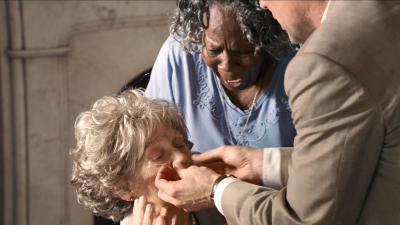
The question we must ask ourselves is “how can a scene so graphic, so disturbing, be so funny, particularly when it’s played completely straight faced?” Yes, Cage’s drugged state allows us to rationalize his exaggerated performance, but the fact that this maniac is the one upholding the law isn’t any more acceptable because he’s high. That the audience is led to treat the scene as humorous, even if the humor is of the gallows variety, reveals Herzog’s mastery in setting and varying the tone of the film. Where most filmmakers would treat Fahringer’s asphyxiation as a turning point for McDonagh’s fall into darkness or a zany gag to keep the mood light, Herzog has it both ways and the results are undoubtedly disturbing. Still, if the film manages to work as a comedy, it doesn’t do so solely on the merits of its questionable and disturbing moments, it also relies on good old-fashioned absurdity to grease the proceedings, giving us permission to laugh at the darker material.
Absurdity and The Bad Lieutenant
Not all of ??Bad Lieutenant??’s humor comes from the rapid fire alternation between McDonagh’s public persona as an honorable police officer and his reality as a doped up crook. Herzog’s fascination with animals, the film’s musical cues and the sheer erratic nature of Nicholas Cage’s character in the film’s second half also fuel the film’s comedic leanings. Of these elements, The ??Bad Lieutenant??’s odd fascination with the animal kingdom seems the most indulgent: a cheap way to get laughs while ticking off a stylistic prerequisite to assert Herzog’s status as an auteur. The director shot the animal close-ups himself and at first, their insertion into the film is at best awkwardly symbolic and at worst totally random.
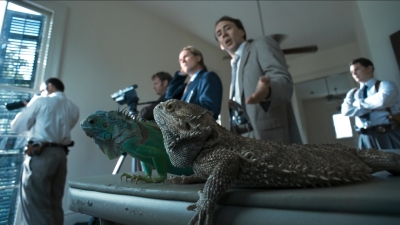
Yet the appearance of iguanas on McDonagh’s coffee table after a drug binge isn’t as farfetched as the sober among us might think: high-level cocaine toxicity has been known to provoke vivid hallucinations of small, uncatchable “creatures” in the corner of the eye and the reptiles tend to appear when McDonagh is at his most unhinged. They first appear before a difficult raid on one of Big Fate’s associates: tensions are high, McDonagh is higher and when he demands to know “what these fucking iguanas are doing on [his] coffee table”, everyone else in the room attempts to ignore the elephant (or iguana) in the room and move on. This alone would simply make for a quirky example of McDonagh’s drug use but then the scene ends on an unusual musical cue: a pained, boozy and bluesy cover of schmaltzy crooner Engelbert Humperdinck’s “Please Release me” by New Orleans bluesman Johnny Adams. The New Orleans connection makes sense, given the film’s location, but the sudden shift from the film’s standard framing to an extreme, low resolution close-up of the two animals set to the song is so unexpected that one can’t help but laugh at it. An out of focus Cage stands staring and the two (inexistent?) reptiles, which remain immobile as the torch song chugs along. There’s no proper reason for this non sequitur beyond showcasing McDonagh’s deteriorating mental state, but the scene’s inclusion allows for yet another moment of levity in a film that could have sunk under the weight of its own gloom. Other feral cameos including that of a roadside alligator shot in the same manner are less extreme in their break from the film’s narrative but they also serve the purpose of divorcing us from the supposedly serious narrative while showcasing the film’s absurd, almost surreal nature and Cage’s degenerating mental health.
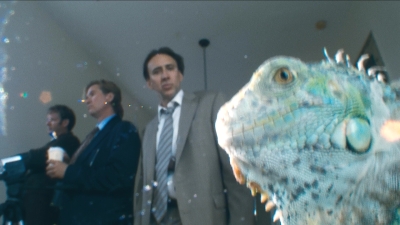
“Please, release me, let me go”
It’s towards the end of the film that Cage’s instability reaches its comedic high point. Under pressure from a bookie trying to collect, gangsters attempting to extort him, internal affairs charging him for Fahringer’s asphyxiation and the crippling substance abuse tearing him and his family apart; McDonagh slips into darkness, aligning himself with Big Fate and fulfilling his role as the titular Bad Lieutenant. Or so it seems, while McDonagh eventually double-crosses Fate, either through devious machination or sheer dumb luck, his temporary on-screen alliance allows Cage and Herzog to dispense with all pretense of order, giving the character free reign to follow his worst impulses. He warns Fate about an impending drug raid, pragmatically discusses the intricacies of river-front real-estate with his new partner while goons dump a body into the river and later extorts a college-football star for profit, forcing him to throw a big game or face a career ruining marijuana charge. As an audience, we’re actually more comfortable with this behavior than many previous transgressions: at least we (think we) know where McDonagh now stands without any of the ambiguity previously surrounding his character. Big Fate however, soon feels anything but comfortable around McDonagh who randomly pulls out a gun and demands a cut of Fate’s uncut cocaine. The scene is fraught with tension, as serious as any other moment in the film, showcasing McDonagh’s instability not as a source of laughs but as a serious pathology…until the crooked cop suddenly quotes LL Cool J’s “To the Break of Dawn” and explodes in a fit of maniacal laughter, instantly diffusing the tension and providing yet another example of the film’s sudden shifts in tone. At this point, it becomes impossible to tell if we’re seeing a realistic portrayal of lost sanity due to drug abuse or a film whose creators are having a laugh at their more serious audience members’ expense. It becomes tempting to abandon any pretense that Bad Lieutenant is anything but a comedy in dramatic clothing, Cage’s unstable outbursts tending to overshadow any social commentary or narrative tension the film might otherwise hold as a drama. That said, McDonagh’s zaniness is not pointless as Herzog deftly manages to end the film’s main narrative arc through its funniest, most extreme set piece.
Terrence places a supposedly sure bet on Louisiana State whose star player he’s blackmailing. When he returns to Big Fate’s office to collect his money, the debt collectors extorting him secretly give chase. At his hideout Fate is in a jubilant mood, smoking crack and praising McDonagh for his services. He’s also cautious after McDonagh’s last outburst in the car and the camera pans down to see him holding a double barrel shotgun tucked under his desk. In the throws of addiction, McDonagh immediately asks for a hit of Fate’s crack pipe, much to the gangsters’ surprise. Then, Cage delivers the film’s best performance: mimicking the drug’s ultra-speedy rush, the actor begins to ramble a series of nonsensical comments including a racist diatribe about a College football player, a paranoid warning not to worry about his condition and a random comparison between himself and rapper Easy E. As loud and over the top as any vintage performance by Jim Carrey or Mike Myers, Cage’s unhinged monologue is laugh out loud hilarious. It’s also scarily accurate which leads the audience to wonder about the ramifications of laughing at crack cocaine abuse. Going 20 years on American crack epidemic and over 5 since Comedian Dave Chappelle turned the crackhead into a comedic archetype, Cage’s outburst remains disturbing but buried in the depths of an already funny and confusing film, we accept it without question. After the outburst, McDonagh offers Fate a hit off his own “lucky crack pipe,” an act with important ramifications but one that’s immediately interrupted by the arrival of McDonagh’s gangster debt collectors. The film’s tone immediately shifts back to that of a serious crime drama. Herzog is once again playing with our expectations: we’ve shifted from crack induced hysteria, to grim seriousness in an instant with only a subtly hidden plot point (Fate hitting Terrence’s crack pipe) in between. And then, at the height of the tension, Fate’s crew explodes into a shootout to the sound of a (supposedly) non-diegetic harmonica solo, exterminating the debt collectors. The result is sheer parody: more wild-west free for all than gangland massacre, the film’s tone finally going into full blown comedy. Cage then seals the deal instructing Fate’s associates to shoot the dead man again because “his soul’s still dancing” as we witness the incredulous sight of the debt collector’s corpse break dancing. The scene closes with a single iguana slithering past the bodies.
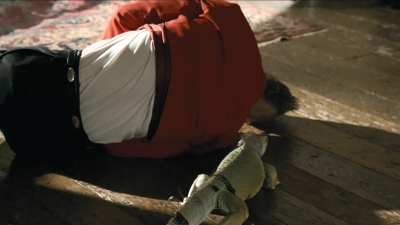
Endgame: more questions than answers
Bad Lieutenant ends as most cop films do: the lawman arrests the bad guy. In this case, McDonagh suggests to a fellow officer that he inspect Fate’s house for a crack pipe with DNA linking him to the film’s initial murders. Meanwhile, he returns home only to witness the Louisiana player he attempted to extort sitting out the game and the team on which he bet losing by a seemingly certain margin. He proceeds to pass out, drugged, depressed and wrecked. In most films, we would witness the tragic hero’s downfall at the hands of drugs…but not here. The next morning, the well-connected john who sent his now-dead debt collectors after Terrence is waiting for him and offers an olive branch. Then, Terrence’s bookie comes in and miraculously announces that Louisiana won by three despite the failed extortion. Finally, Terrence’s chief enters grinning from ear to ear and announces that they have proof to convict Fate thanks to Terrence’s tip about the crack pipe. Everything is perfect…so perfect that as an audience we can’t help but think this is a dream sequence! Nothing works out so perfectly in real life, does it?
In Bad Lieutenant, it does and once again our expectations are upended. McDonagh has done everything wrong yet everything he’s done has worked out perfectly! A year after Fate’s arrest, McDonagh is promoted to captain. His father, mother-in-law and girlfriend sit beaming, all apparently sober, so sober that they turn down wine in favor of sparkling water. The illusion of normalcy that McDonagh struggled the whole film to maintain has apparently become reality. This is as major a rejection of Hollywood convention as the film’s irreverent humor: crack addicted, extortionist cops MUST pay a price if they are to emerge from their drug addicted haze as better men. That addiction and Machiavellian behavior itself would fuel a cop’s rise to respect is nihilistic and immoral yet Herzog shows us that very scenario. Those following the director’s oeuvre aren’t likely to find this twist surprising, but in the context of the film itself, it remains shocking. Even when it is revealed that McDonagh continues to lead his double life of drugs and debauchery, it is given no moral weight. In fact, in a final flippant send off, the now sober criminal who Cage saved at the beginning of the film discovers McDonagh nodding off in a hotel room. The film ends on an uncertain note: did McDonagh send the sober man back into delinquency or will the reformed man save Cage? The film’s final shot of the two men staring blankly in front of an aquarium can be interpreted either way.
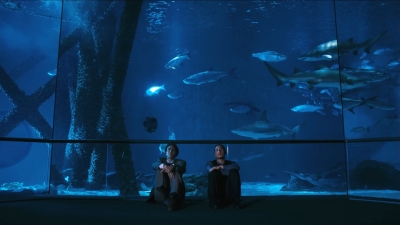
Herein lies The ??Bad Lieutenant??’s ultimate joke: it is as funny or serious a film as the audience wants it to be. By treating serious issues as simple flippant realities of life with no particular importance accorded to their morality, Herzog and Cage ultimately present a chaotic, nihilistic vision of life that spits in the face of Hollywood’s out-dated notion of right and wrong. Audiences expecting a narrative to reassure them or teach them something leave confused, angry or shocked, those with open (or cynical) minds leave laughing at the film’s absurdity. The film’s open-ended approach to the story it tells, but also its meaning can only be defined in relation to its audiences reaction: one that’s often laughter but also shock, dismay and surprise, much like life itself. Laugh and the world laughs with you.


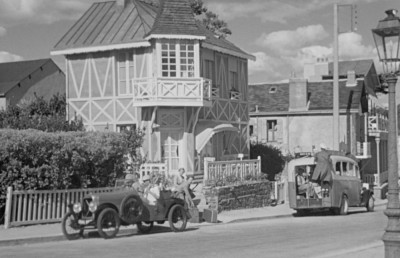
_400_258_90_s_c1.jpg)
